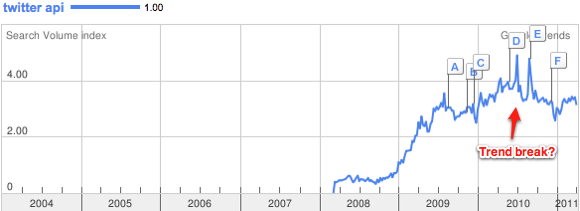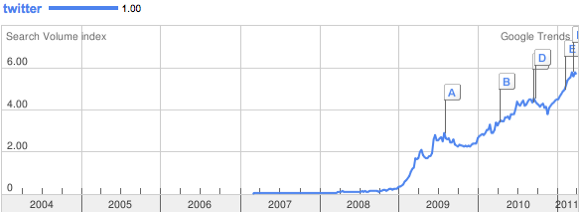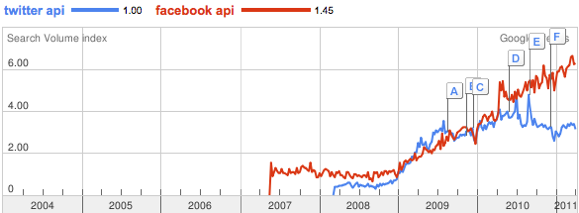![]() Twitter became what it is today largely thanks to a big and very enthusiastic community of third-party developers who built applications on top of the fast-growing service. There were other factors as well, but few would argue that strong support from its developer community hasn’t been key to Twitter’s success.
Twitter became what it is today largely thanks to a big and very enthusiastic community of third-party developers who built applications on top of the fast-growing service. There were other factors as well, but few would argue that strong support from its developer community hasn’t been key to Twitter’s success.
For developers, the Twitter API has been almost as hot a commodity as the Twitter service itself. So imagine our surprise when we noticed that worldwide interest in the Twitter API seems to have dropped off since mid-2010 (based on search statistics from Google).

The timing of this dip is highly interesting. The trend break is around the time when Twitter announced its own, official client application for iPhone, and Twitter investor Fred Wilson wrote his famous blog post, The Twitter Platform’s Inflection Point, telling developers to stop filling the obvious feature holes in Twitter’s product because Twitter would eventually get there on its own, instead trying to nudge developers toward creating the next “killer app.” (It’s a good article, so check it out if you haven’t already read it.)
In short, Twitter’s attitude towards its developer community began to change about a year ago, becoming more restrictive, less welcoming. Twitter has been working diligently on taking back control over how people access its platform, and third-party apps are still widely used to access Twitter, something the service isn’t always too happy about. This culminated in March, when Twitter basically told third-party developers straight out that they shouldn’t make Twitter clients anymore.
And as the above graph indicates, Twitter’s more reluctant attitude toward developers seems to have had a real effect on the interest in its API. Is it showing the effect of developers getting cold feet? We suspect so.
Before you think this is a general drop in interest in Twitter, we should point out that that is very much not the case. Here’s the same curve just for “Twitter.”

As you can see, interest in Twitter is still rising sharply, and we know the service itself is still growing fast. So why should the Twitter API suddenly start to get less interest from developers? That doesn’t make any sense, unless you actually consider the various statements and policy changes that Twitter has made in the past year.
Another interesting comparison point is a different “social API,” that of Facebook.

At this stage, with Twitter still growing rapidly, developer interest should not be evening out. It should still be growing, as it is for Facebook’s API.
We love Twitter (we’re @pingdom), but the company has indeed been a bit heavy-handed with their developer community lately so perhaps we shouldn’t be surprised that interest in the Twitter API has dropped off a bit. Hopefully this is just a temporary lull, because as we pointed out earlier, the immense attention that Twitter has received from developers is arguably one of the main keys to its success so far.
Data source: Google Trends
Final note: This is all definitely what would count as circumstantial, non-binding evidence. We may even be drawing the wrong conclusions, but you have to admit that those graphs are telling a pretty convincing story.



























